Menus
- The curve search engine from Mattighofen
- MOTORCYCLE points evaluation / conclusion
- Technical data / noticed
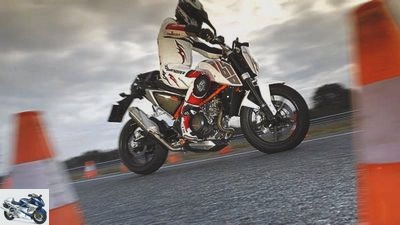
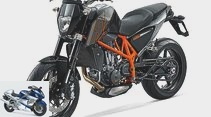
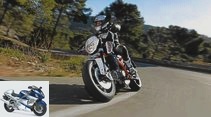
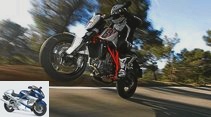
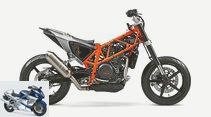
20th photos
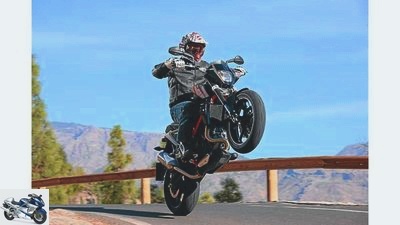
1/20
Such deposits are no problem for the single.
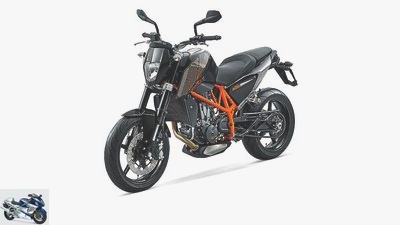
2/20
Also available in black – the KTM 690 Duke.
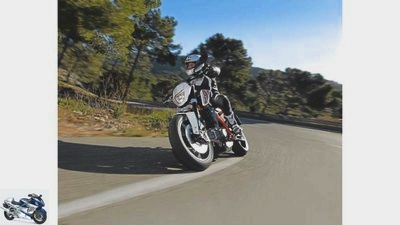
3/20
The curve search engine – KTM 690 Duke in the top test.
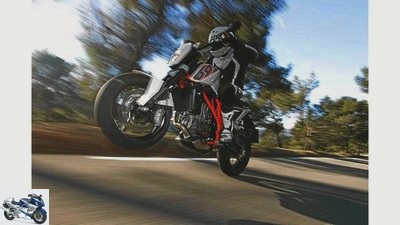
4/20
Raise the cups: The playful handling still shapes the character of the single-cylinder lighter.
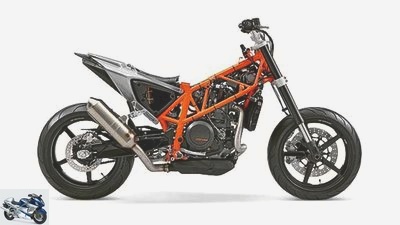
5/20
Stripped almost even more beautiful: clear technology, cleanly made and finely processed.
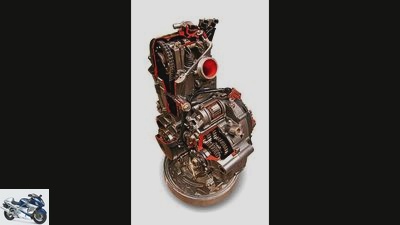
6/20
Real size: With just over 70 hp from 690 cm3, the LC4-Single has a specific output of more than 100 hp / liter.
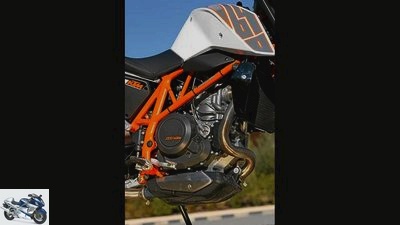
7/20
Ignites twice: only the Duke has the 690 single-cylinder with two spark plugs and real ride-by-wire.
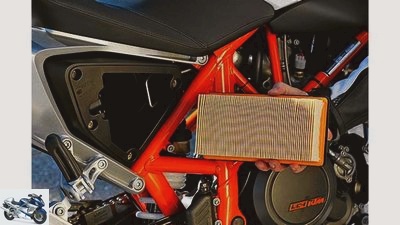
8/20
No breathing space: the giant single gasps for air through astonishingly small intake snorkels and a paper air filter.
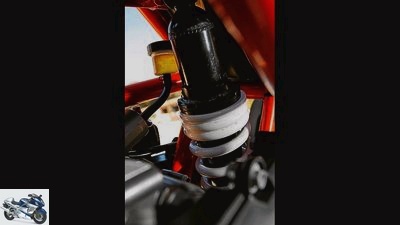
9/20
Saved: shock absorber with steel housing without screws and expansion tank.
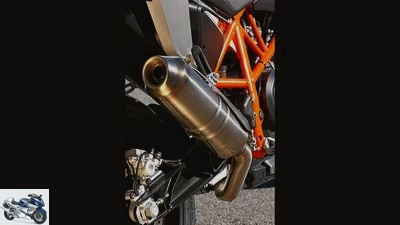
10/20
Muffled: The exhaust does its job almost too well.
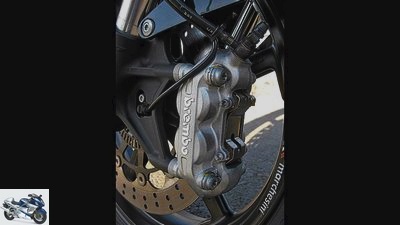
11/20
Everything under control: The Bosch ABS has its problems with the lightweight Duke.
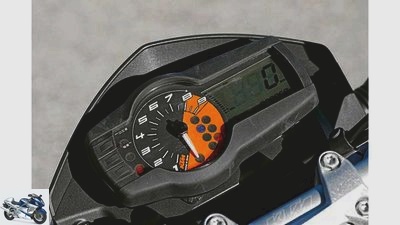
12/20
Clockwork orange: display in the typical KTM look, but not particularly easy to read.
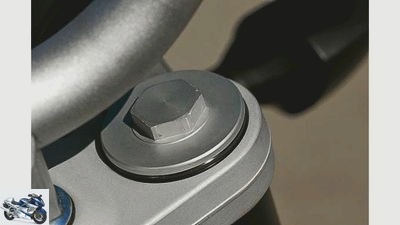
13/20
Simple: where there is nothing to be adjusted, nothing can be adjusted.
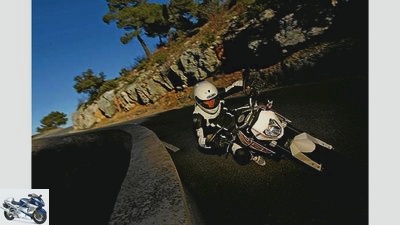
14/20
On a knife’s edge: no machine can master curve dancing as playfully as the Duke.
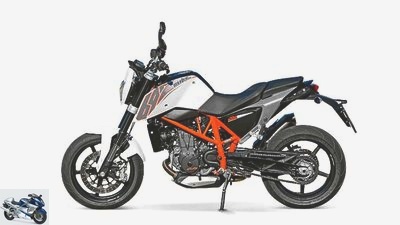
15/20
KTM 690 Duke.
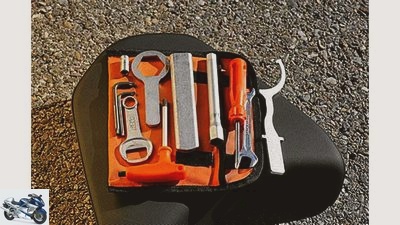
16/20
Solid on-board tools are a matter of course at KTM, but the Duke is not particularly extensive.
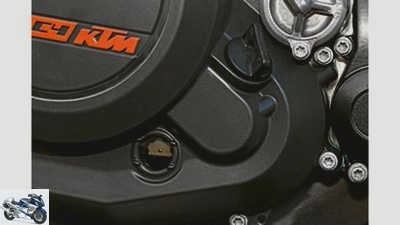
17/20
The oil level can be seen at lightning speed on the sight glass, refilling is also easy.
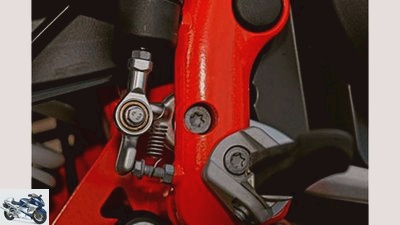
18/20
The workmanship is really great, which is by no means a given in this price range. Note pretty details like the hinge eye on the linkage of the rear brake.
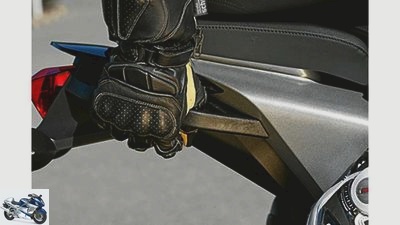
19/20
There are solid handles for the pillion passenger, but there is little space and comfort. The Duke is more of a solo machine.
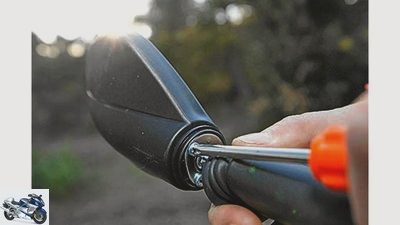
20/20
Both mirrors on the test machine adjusted automatically. This could be easily remedied by tightening the clamping screws.
KTM 690 Duke in the top test
The curve search engine from Mattighofen
There are many results for KTM under the search term “curve wetter”. At the top, however, is certainly the Duke, an inclined speedster with addictive potential. It should now be more suitable for everyday use, more sociable, easier to care for. The edgy and capricious diva has now become Everybodys Darling?
F.Don’t just stop around the block, as a tip in advance. Take your time, treat yourself to an hour. A short test drive could give the wrong impression, maybe even put you off. Because a Duke drives differently, acts differently, behaves differently than anything else on the motorcycle market. If you switch from a common multi-cylinder all-rounder, the KTM single will seem very hectic, extremely direct and quite nervous. Another world, the synapses have to get used to.
Buy complete article
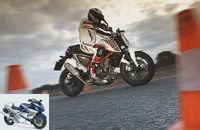
KTM 690 Duke in the top test
The curve search engine from Mattighofen
With the current model, KTM did a lot to teach the single-cylinder manners. The core of the engine and chassis was retained, but pretty much everything around it was rebuilt. Visually, the new one definitely appears more pleasant to the taste, less angular, less elitist.
But let’s start with the drive, which so decisively shapes the character of this handy speedster. With a full 690 cm³ it basically comes from the old R-Duke and now hammers in all three current 690 models.
The small difference between Duke and the other two is first of all a dry cable. Namely the one that now connects the throttle grip and throttle valve. So the good old Bowden cable has had its day here. For older drivers from the analog era, irritating when the electronics take control. Now the on-board computer accelerates, the black box takes care of things – hmmmh. All current cars prove that it works, and even Harley (!) Has been secretly doing this for years with the big tourers.
We want to be the first to check this out here on our demanding test slope in southern France. So the clutch – by the way, thanks to the built-in servo function, it’s incredibly easy as before – out, the throttle grip – it also turns incredibly easily – open and you go forward. It’s impressive how easy it is to control how smoothly the single cylinder starts from a standstill in the partial load range. Nothing rattles there, nothing rattles. The LC4-Single hangs cleanly, much better than before on the literal cable, jerks less, runs more smoothly than ever before. Real progress.
Sure, the clock, which is not particularly easy to read, should still be 3000 revolutions, and the electronically controlled throttle does not change that. At the very bottom, this sports hammer simply lacks the flywheels.
The curve search engine – KTM 690 Duke in the top test.
The optimized running smoothness is not only due to the aforementioned cable, at least as much to the ingenious double ignition adapted from the RC8 R. A measure that has a beneficial effect in view of the enormous combustion chamber. In addition, the mapping now works aisle-specific. In addition, the mass balance has been optimized, which manifests itself in reduced vibrations in the upper speed range.
Fine, when such improvements in running smoothness not only cost no performance, but even bring more power. Compared to the “small” 653 of the previous basic Duke, the new one naturally has more boom everywhere. But the larger displacement is by no means at the expense of the maneuverability. Compared to the 690 R engine that works in the current SMC R and Enduro R models, the double-ignition engine has increased between 3000 and 4000 revolutions at the bottom and at the top. The increase may not appear particularly abundant on paper, but in practice it results in a noticeably wider usable band.
You can now easily roll along in urban traffic at 3000 revs, then overtake a truck with your wrist without shifting gears. And outside in the wild the enormous liveliness for such a shooter inspires. While the old engine no longer really wanted after the performance peak, which was also indicated by rough vibrations, the new one often thrashes into the limiter at first.
72 HP from a single cylinder, that is of course a word, especially since you always have to see the performance in combination with only 163 kilograms of live weight. This results in inspiring driving dynamics. The part snaps out of the curve that even a Super Duke moving in the test at the same time has a lot of trouble following the mono. The sporty, short gear ratio enhances the effect. The Duke runs into the limiter at a measured 197 km / h without a big start.
The euphoria is only slowed down by the fact that an essential component of the emotional experience is completely missing: sound. While the single-cylinder freak likes to forego all too pithy vibrations, he sorely misses an acoustic background that is adequate for the experience offered. The powerhouse whispers. No thunderous shooting, no hammering blow, just hot air. Certainly, dear Austrians, the single cylinder is already prepared for future emissions regulations, but a little more sound, a little more acoustic sex appeal would be nice.
In contrast, every BMW is a riot bag. In any case, strict compliance with the regulations has one advantage: low fuel consumption. The single cylinder only sips cautiously from the fuel supply, the fun device consumes a meager 3.8 liters per 100 kilometers.
This feeling of incomparable lightness that the engine exudes cannot be decoupled from driving behavior. Objectively, the Duke is fast on the handling course, but not the fastest. Subjectively, the handling is perceived as incredibly playful, extremely light-footed. The part reacts so directly and spontaneously that the choice of line is a bit haphazard at first. Once you have prepared yourself for it, the Duke strikes unbelievable hooks, finds a lightning-fast answer to every crazy route, to every surprise in traffic. Sharpening curves in another dimension.
In terms of ergonomics, KTM gradually seems to be heading in a new direction. The Duke has a real seat, no longer one of those narrow, rock-hard wooden benches for which the off-road specialist was once known.
Stripped almost even more beautiful: clear technology, cleanly made and finely processed.
You can now speak of comfort. Especially since in Austria it has now become apparent that there are also people outside the Alpine valleys who do not have the standard of a guard. The seat height has been lowered by a full 30 millimeters compared to its predecessor. Which leads to the fact that emotionally you are now sitting in rather than on the motorcycle – like with the Japanese. The range of accessories even offers an even lower bench, making the Duke compatible with even the smallest of pilots.
Ironically, that creates a problem on the other end of the scale. A 1.90 meter man feels quite cramped on the Duke, especially since the comfortably shaped seat does not allow any freedom of movement. You sit as if nailed to the ground, which supermoto heaters may not like. But it is clear that the Duke has clearly won ergonomically for the general public and for normal everyday use.
Which also applies to the suspension setup. Here, too, KTM is breaking new ground. The current Duke springs rather softly, responds cleanly, smoothly absorbs even fine ribs and scars in the asphalt. The times of tight hopping are a thing of the past. Nothing can be adjusted apart from the spring preload on the rear of the spring elements. You don’t miss the screws in everyday life, the coordination fits. Only those who turn the shower very hard might find the damping a little weak. Then the pumping rear brings unrest into the chassis, and here and there the suspension goes so far that the damper housing noticeably touches the rubber buffer. The same thing often happens in pillion rides. The spring can be pretensioned very quickly with on-board tools, but that does not prevent it from bottoming out or moving. So that no wrong impression is created: This is whining at a high level, in everyday solo operation the chassis not only works perfectly, but also excellently.
In any case, the Duke is still more a case for soloists. Because the passenger has to fold up badly on the short seat cushion. Another point where cost-cutting measures are evident is the braking system, which is now controlled by an ABS as standard. Instead, the radial pump was omitted, which costs a little transparency. Emergency braking requires a lot of manual effort and good vehicle control. The Duke wedges slightly, sometimes suddenly lifting the rear end, and the function of the ABS is not always transparent during heavy braking maneuvers. Sometimes the rollover detection intervenes relatively early, sometimes it allows heavy stoppies. But the same applies here as for the chassis: In normal life, far below the limit range, the brakes work more than properly.
An incomparable speedster to which there is no alternative in the single-cylinder area. And which delights its owner with a first-class finish and dignified workmanship despite all the need to save. The Duke remains the fun device that could inspire even more fans with its grandiose lightness and improved manners.
MOTORCYCLE points evaluation / conclusion
On a knife’s edge: no machine can master curve dancing as playfully as the Duke.
engine
Given the manageable peak performance, acceleration and pulling power are really fast. The Duke runs into the limiter at 197 km / h without a big start. Clutch and gear shift work smoothly. At low temperatures, the single cylinder starts a bit tough. The response and load change behavior are excellent for a single cylinder. The clutch and throttle are extremely easy to operate.
landing gear
The single cylinder scurries through the handling course with agility. Straight ahead the Duke runs relatively stable, in corners a bit more restless. The latter not least because of the soft suspension set-up, which is more geared towards comfort than driving on the last groove. The adjustment screw for the chassis was saved. The Michelin tires harmonize perfectly with the chassis.
everyday life
Everyday seating comfort for the driver is significantly improved, and the wider cushion offers a comfortable place even on longer journeys. The mirrors only give a shaky image of the traffic behind. There is really nothing to complain about in terms of workmanship, the Duke is made great down to the last detail.
security
The braking effect is certainly good in everyday use, if not outstanding. There is room for improvement in terms of feedback and ABS, which does not always prevent stoppies. In addition, the Duke does not remain stable on course when braking hard.
costs
A big plus: inspection intervals extended to 10,000 kilometers and correspondingly lower costs. The low fuel consumption is also positive.
Price-performance
More points than before, but above all a greatly reduced price: that results in a great price-performance rating.
Conclusion:
A fantastic engine, improved manners, more suitability for everyday use: The Duke has clearly won – and at a competitive price too. Most of them will be able to get over the fact that a few compromises have to be made in the high-end area. It’s just a shame that the sound comes across so pale, some people will include the accessory exhaust in the price calculation.
Technical data / noticed
No breathing space: the giant single gasps for air through astonishingly small intake snorkels and a paper air filter.
engine
Water-cooled single-cylinder four-stroke engine, a balance shaft, an overhead, chain-driven camshaft, four valves, roller rocker arm, dry sump lubrication, injection, Ø 46 mm, regulated catalytic converter, alternator 224 W, battery 12 V / 8 Ah, hydraulically operated multi-disc oil bath clutch, ( Anti-hopping), six-speed gearbox, O-ring chain, secondary ratio 40:16.
Bore x stroke 102.0 x 84.5 mm
Cubic capacity 690 cm³
Compression ratio 12.6: 1
rated capacity 51.5 kW (70 hp) at 7500 rpm
Max. Torque 70 Nm at 5500 rpm
landing gear
Steel tubular frame, load-bearing motor, upside-down fork, Ø 43 mm, two-arm swing arm made of aluminum, central spring strut with lever system, adjustable spring base, front disc brake, Ø 320 mm, four-piston fixed caliper, rear disc brake, Ø 240 mm, single-piston floating caliper, SECTION.
Cast aluminum wheels 3.50 x 17; 5.00 x 17
Tires 120/70 ZR 17; 160/60 ZR 17
Tires in the test
Michelin Pilot Power
Dimensions + weights
Wheelbase 1466 mm, steering head angle 63.5 degrees, caster 115 mm, spring travel f / r 135/135 mm, permissible total weight 350 kg, tank capacity / reserve 14.0 / 3.2 liters.
Service data
Service intervals 10000 km
Oil and filter change every 10000 km 1.7 l
Engine oil SAE 10W50 / 60
Telescopic fork oil SAE 5
Spark plugs NGK LKAR8BI9, NGK LMAR7A-9
Idle speed 1600 ± 50 / min
Tire pressure front / rear 2.0 / 2.0 (2.0 / 2.2) bar
Two year guarantee
Mobility guarantee two years
Colors black, white
price 7495 euros
Additional costs around 250 euros
Noticed:
positive
- Solid on-board tools are a matter of course at KTM, but the Duke is not particularly extensive.
- The oil level can be seen at lightning speed on the sight glass, refilling is also easy.
- The workmanship is really great, which is by no means a given in this price range. Note pretty details like the hinge eye on the linkage of the rear brake.
- The complete exhaust system including painted front silencer is made of stainless steel.
Negaitv
- The light didn’t get better, the cone is still pale and spotty.
- There are solid handles for the pillion passenger, but there is little space and comfort. The Duke is more of a solo machine.
- Both mirrors on the test machine adjusted automatically. This could be easily remedied by tightening the clamping screws.
Related articles
-
Jahn Top test KTM 690 Duke The Duke Offensive We want to throw all petty concerns overboard and knit a radical landing gear around the most brutal…
-
KTM 690 Duke R, KTM 690 Enduro R, KTM 690 SMC R in the test
KTM 31 pictures KTM 1/31 KTM 690 SMC R. KTM 2/31 KTM 690 SMC R. KTM 3/31 KTM 690 Duke R. KTM 4/31 KTM 690 Duke R. KTM 5/31 KTM 690 Duke R. KTM 6 / 31 KTM 690 …
-
Comparison test KTM Duke against MuZ Mastiff
Comparison test between KTM Duke and MuZ Mastiff Must be fun Who says that a serious comparison test shouldn’t also be murderous fun. KTM …
-
Comparison test between Husqvarna Vitpilen 701 and KTM 690 Duke
r-photography.info 20 pictures r-photography.info 1/20 Husqvarna Motorcycles Vitpilen 701 and KTM 690 Duke in comparison. r-photography.info 2/20 …
-
KTM 1290 Super Duke R in the 50,000 km endurance test
44 pictures 1/44 endurance test final balance sheet KTM 1290 Super Duke R. r-photography.info 2/44 autumn trip, the first: …
-
Comparison test: KTM Super Duke R against MV Agusta Brutale 990 R
Comparison test: KTM Super Duke R against MV Agusta Brutale 990 R Sporty naked bikes in the test Content of A feast for the senses: The new MV …
-
35 pictures 1/35 The highly successful 690 Duke KTM is now also offering a classy R-version with fully adjustable …
-
KTM 690 Duke and Yamaha MT-07 in comparison test
www.factstudio.de 25 pictures www.factstudio.de 1/25 Power on the crankshaft. Measurements on the Dynojet roller test stand 250, corrected according to 95/1 / EG, …
-
Comparison test of 125cc naked bikes – Aprilia Tuono 125, Yamaha MT-125 and KTM 125 Duke
18th photos 1/18 Away with the smartphone, boys and girls. Forget twit snap and insta chat because real life takes place out…
-
KTM 790 Duke in the 50,000 kilometer endurance test
Flash Art 17 pictures Baumann 1/17 Uli Baumann, editor at motorradonline.de: The Duke 790 is a guarantee of fun in the countryside, but in the city it looks completely …